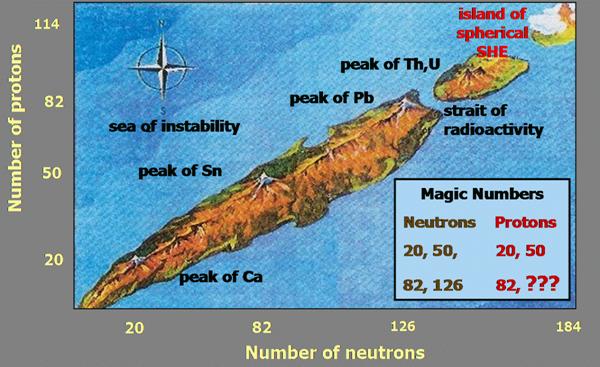
The concept of the nuclear mean field and its quantitative realisation in the nuclear shell model form the bedrock of our understanding of the structure of atomic nuclei. For decades, one of the longest standing, but as yet unverified, predictions of that formalism suggest that, for the transuranic nuclei, magicity may be assigned in the region of neutron number N=184 and proton number Z=114. Thus a nucleus with neutron and proton numbers which coincide with these values would be doubly magic and spherical. Moreover, the additional stability that arises from the shell closures produces an additional binding energy and an increased barrier against fission, and hence a greater probability that the nuclei in this region may exist at least sufficiently long for their properties to be measured. The region around the neutron and proton shell closures has thus been called an ‘Island of Stability’ and the discovery of the consequent so-called superheavy nuclei represents a Holy Grail for nuclear physics. [1,2]
Together with our colleagues in Jyväskylä, Finland we use gamma-ray and conversion electron spectroscopy to understand the structure of superheavy nuclei using the SAGE spectrometer [3]. An important role is played by isomeric states which can provide clean structural information on excited states [4]. Recently we are working towards a first direct lifetime measurement in an excited state in a superheavy nucleus [5].
At GSI we collaborate with colleagues from Germany, Sweden, and the US to study the production [6] and decay of superheavy elements [7], including their chemical properties which determine the placement of the element in the periodic table [8].
[1] R-D Herzberg & PT Greenlees (Prog. Part. Nucl. Phys. 61 (2008) 674-720
[2] Special Volume Nuclear Physics A 944 (2015), edt. Ch. Düllmann, R-D Herzberg, W. Naczarewicz and Yu. Oganessian
[3] J. Pakarinen et al., Eur. Phys J. A (2014) 50: 53
[4] R-D Herzberg et al., nature 442 (2006) 896
[5] L. Barber et al., Nucl Instr. Meth. A 979 (2020) 164454 and J.Heery et al, submitted to EPJA
[6] J. Khuyagbaatar et al., Phys. Rev Lett 112 (2014) 172501
[7] A. Samark-Roth et al., Phys. Rev. Lett. 126 (2021), 032503
[8] A. Yakushev et al., Inorg. Chem. 53 (2014), 1624